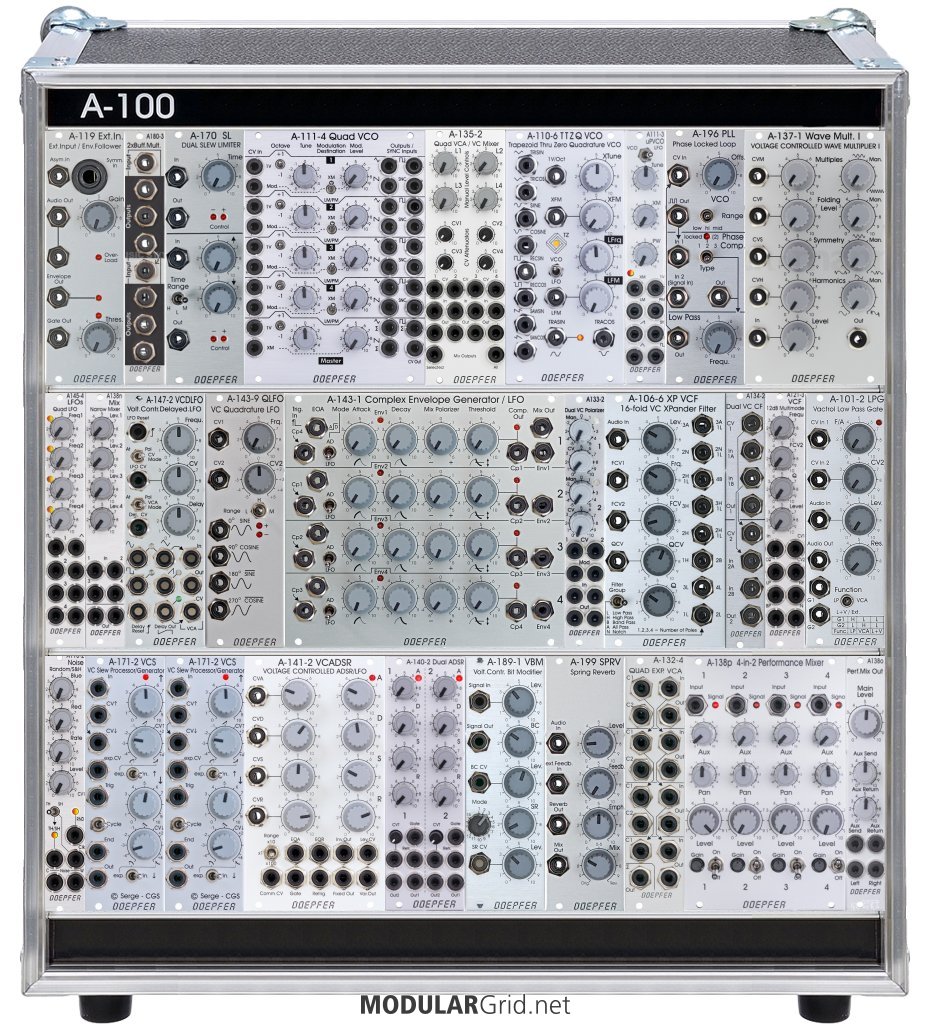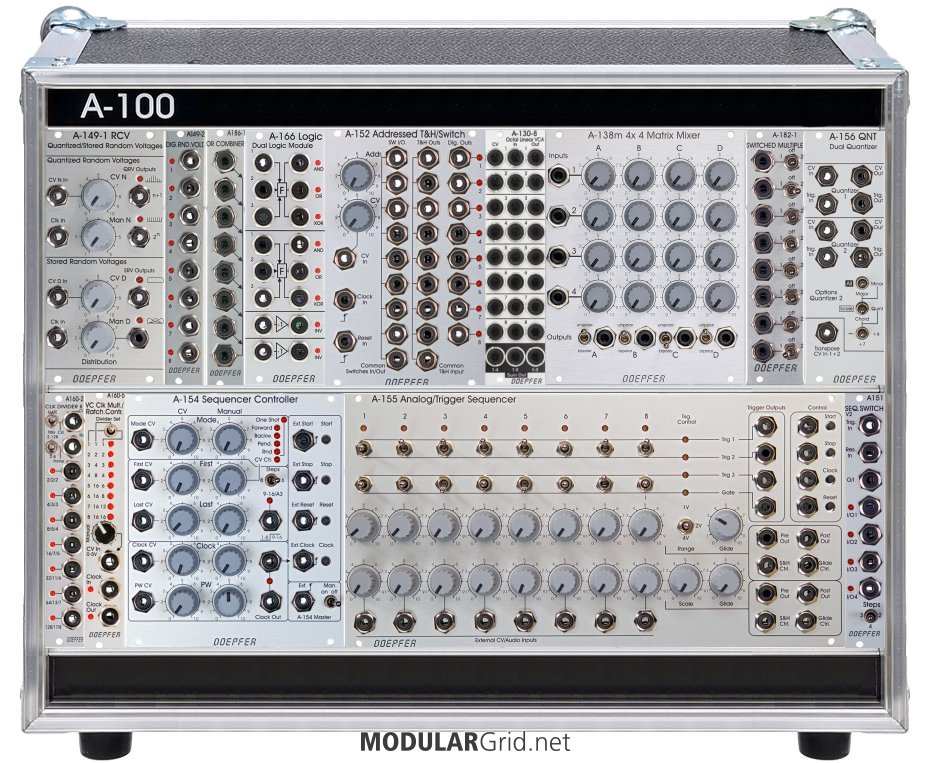The only thing that I can see that's got an exponential response is the A-138 in the lower cab. However, since most everything IS linear, what you might consider would be to yank the A-130-8 and replace it with the A-132-4. This is a similar module with four exponential VCAs, and losing the other four linear VCAs really wouldn't be an issue if you dropped the A-138u for an A-132-1 to replace two that you'd lose. This would then give you six linear VCAs and four exponential.
Another idea would be to drop the A-138u, move the A-183-2 to where it was, then swap the A-133 for an A-133-2, thereby opening another 8 hp. At that point, you could then move the A-130-8 to that newly-opened slot and then put an A-180-2 mult next to it. This then takes you to 12 linear and four exponential VCAs...MUCH better.
I'm gonna bang on this a bit and see if I can up the functionality in some other ways as well...even while staying 100% Dieter here.


That was interesting...I still felt constrained by Dieter's module sizing + a few missing "go to" modules that weren't Doepfer, but I think these beefed up pretty nicely. Considerable changes...here we go...
ngin, Row 1: Added an external input/envelope follower for processing external sources. Then I put the buffered mult next to that, and added a dual slew limiter for portamento (#2 has direction selection). Eliminated some of the VCOs so that I could add a Quad VCO with a Quad VCA, which allows you to CV the mix of the four VCOs. A-110-6 remains, but then there's a uPVCO which is there as a "driver" for the PLL module. These last three generators are more or less intended as individual voice oscillators, but there is a small 4-in mixer there to allow mixing, if desired. After that is the Wave Mult I.
Row 2: Quad LFO with a 4-in mixer, which allows you to blend up complex modulation in a minimal space. Then the VC Delayed LFO went in, more or less an upgrade because of the delay circuit...very useful. I kept some of the quadrature functionality in with a VC Quadrature LFO; you don't necessarily hear quadrature relationships in audio, but for modulation, well...that gets interesting, with the ability to mess with phase. There's a point to it in a bit, same row. Then the A-143-1, and after it is a dual VC Polarizer, which allows you to tamper with modulation results even further. I made some significant changes to the VCF lineup, also...starting with the VC Xpander VCF (replaces the SEM VCF, as the topology for its 12 dB LPF will essentially be the same) which gets tandemmed with the VC Dual Crossfader (hence the Quadrature LFO) which allows you to "morph" between a few different VCF topologies, resulting in some potentially-complex VCF behavior that wasn't there before. Multimode VCF next, then your LPG.
Row 3: Noise/random/S&H starts this off, using that as a replacement for the original noise source to save some space. Then the VCS clones and the VCADSR. After that, I added two more non-CV ADSRs, which now brings the EG complement up to seven EGs totalled. Then the Bit Mod and Spring...although I admit to being a bit torn as to whether the Pedal Interface might've been a better fit for BOTH of these, allowing you to employ external processing for both slots. The BIG fix is next, though...you'll notice the Quad Exponential VCA right next to the 4-in Performance Mixer (and its output module). This NOW lets you have a stereo output from the synth, plus you also have an AUX send/return on the Output module so that you can parallel-process an effect (spring would work well with that). And you also get CV over your mix by patching each of the Exp VCAs to a corresponding Performance Mixer input. Again, you might consider using the Pedal Interface in both of these 8 hp effects slots, as this would then let you slot in any sort of pedal for both...and you can STILL use one of those as an AUX insert with the Performance Mixer.
ctrl Row 1: There's the A-149-1/2, then a Diode OR for combining gates...which is useful for various trickery with the Boolean logic module. A-152...then the Octal Linear VCAs, as these are better suited for CV and modulation, hence the relocation to the "ctrl" cab AND their relocation next to the Matrix Mixer, which then lets you have a similar CV capability as the audio mixing setup in "ngin"...but with VCA control over both the outs AND the ins of the Matrix Mixer itself, if you desire. A switched mult is next, which I added to help with performance-type CV bus switching on the fly. After that is the Dual Quantizer...so the Switched Mult can behave as a manual "router" for your quantized CVs between two different VCO groups.
Row 2: The clock mods are now paired with the Sequencer control for ease of patching. And the 2/3/4-position VC Switch is down at the end of the sequencer, where it needs to be to shift from dual 8 to single 16 CV row behavior.
Now...while making these changes, I tossed a lot of the less-densely-functional modules while trying to make sure that those functions were being replicated elsewhere, so that the functional density (and potential) of the build could be upped while losing as little as I could manage. A few functions didn't exactly make the cut...but not many, because once you start diving into how a lot of the added modules work and what they're capable of, you'll find that most everything from the original builds are still present...and by mashing the crap out of the space, it allowed me to drop in things that really up the capabilities of the build. Also, you'll notice that everything is function-grouped now, running left-to-right and up-to-down on signal flow. This also keeps the end of the audio at the bottom right of the "ngin" cab, making the entire "ctrl" cab purely control-dedicated. Plus, by swapping the sequencing modules to the "flat" row, you now have the system's primary controller where it belongs.
...and it's still 100% Doepfer! Whatcha think?
